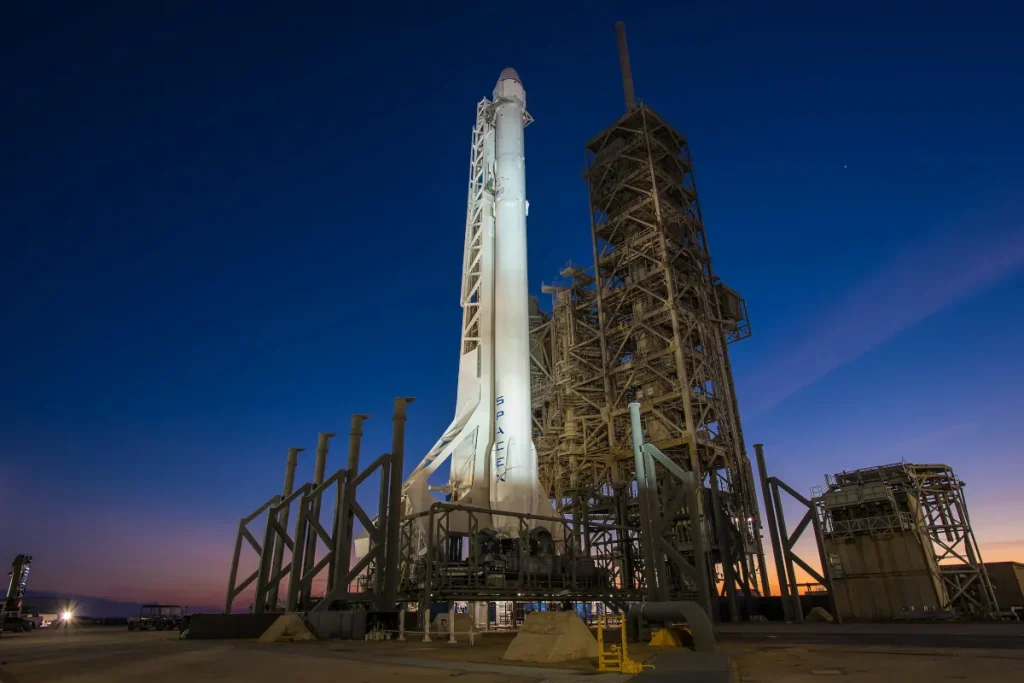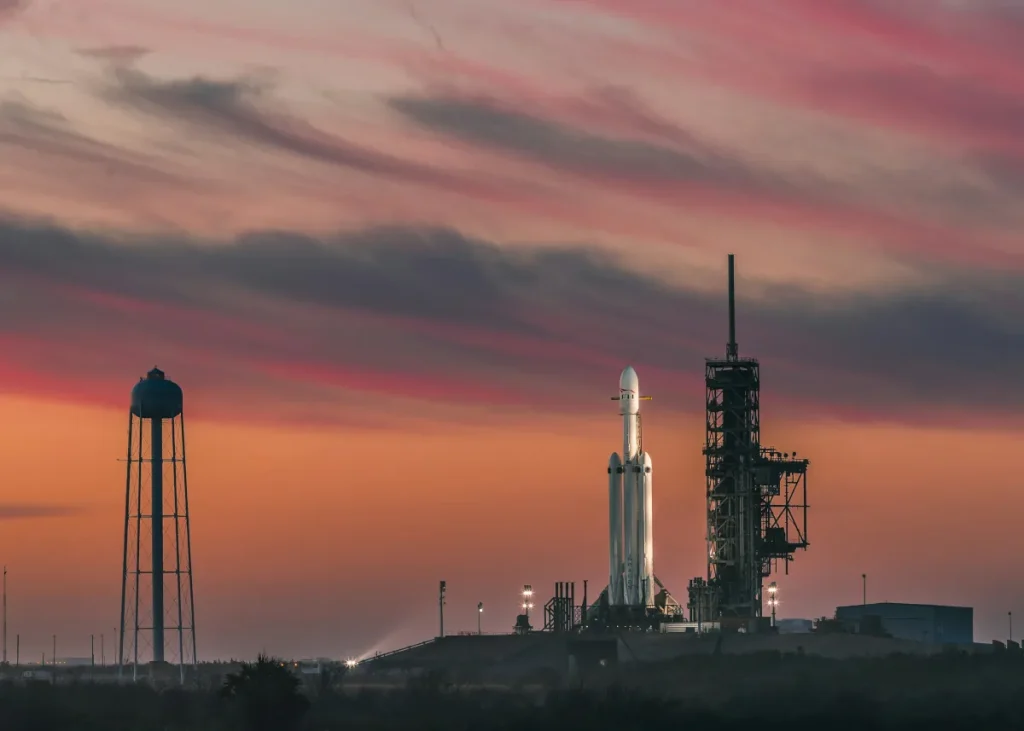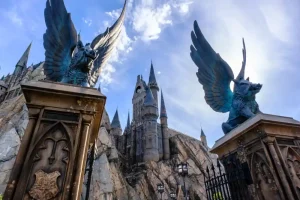2025: Kennedy Space Center & Cape Canaveral Launch Schedule
By James | Last updated April 7, 2025
This page may contain compensated affiliate links. Please read the Disclaimer for more information
This page lists the complete Kennedy Space Center (KSC) rocket launch schedule and the Cape Canaveral rocket launch schedule for 2025 and beyond. This page aims to showcase the space flights happening in Florida, which mainly include SpaceX launches for the majority of launches surrounding the expansion of their space program.

Kennedy Space Center Launch Sites
The rocket launch facility on Florida’s East Coast comprises two launch sites: the civilian NASA Kennedy Space Center and the military Cape Canaveral Space Force Station, which include the “Eastern Range.”
The 45th Space Wing oversees this and looks after nearby Patrick’s Space Force Base. Vandenberg Air Force Base in California is the headquarters of the “Western Range.”
Before you continue, book with our excellent partner at getyourguide.com. They have the best tickets and tours around Florida at unbeatable prices.
Upcoming Florida Rocket Launches for 2025
Note that all launch dates are provisional and are subject to change; you should always check with the Kennedy Space Center before making a memorable trip.
Below is a complete list of planned rocket launches from the Kennedy Space Center and the Cape Canaveral Space Force Station from 2025 onwards, where you can watch a rocket launch.
All times are local times.
Abbreviations:
- EDT — Eastern Daylight Time
- EST — Eastern Standard Time (during the winter months)
- NET — “No earlier than”
- TBA — To be announced
Click here for the complete rocket launch manifest for 2024.
January 15 2025 SpaceX Falcon 9, Blue Ghost (CLPS-19D)
The SpaceX Falcon 9 rocket will launch the Blue Ghost lunar lander for Firefly Aerospace.
Blue Ghost will carry several payloads as part of NASA’s Commercial Lunar Payload Services (CLPS) program.
The lander will touch down at Mare Crisium in the Moon’s Crisium basin. The launch took place on 15 January 2025 at 06:11 UT.

April 9 2025 – ULA Atlas V Kuiper 1
Atlas V 551 rocket, with five rocket boosters, will launch Kuiper satellites into space. This launch marks the start of a new phase in the commercial space industry as Amazon teams up with ULA to send advanced satellites into space. They will use Atlas V as part of the largest commercial launch deal in the world.
The launch will take place from Space Launch Complex 41 – Cape Canaveral Space Force Station.
Net May 2025 – Axiom Mission 4 (Ax-4)
The Ax-4 mission will mark the return of human spaceflight for India, Poland, and Hungary, with each country’s first government-sponsored spaceflight in over 40 years. While this is the second human spaceflight for these countries, it will be the first time all three will be part of a mission aboard the International Space Station.
The Astronaughts include: Peggy Whitson – Commander; Shubhanshu Shukla – Pilot; Sławosz Uznański-Wiśniewski – Mission Specialist, and Tibor Kapu – Mission Specialist.
Net 2025 – United Launch Alliance Vulcan Centaur, Sierra Nevada Dream Chaser
The Vulcan Centaur rocket will launch the sixth Sierra Nevada Dream Chaser to the International Space Station.
The launch will be from launch pad SLC-41. This flight was delayed from late 2024.
2025 TBC – United Launch Alliance Vulcan Centaur, Sierra Nevada Dream Chaser CRS-1 (SNC Demo-1)
The Vulcan Centaur rocket will launch the first Sierra Nevada Dream Chaser, an uncrewed, fully autonomous, reusable mini space shuttle on a mission to the International Space Station. Dream Chaser can land on a runway after re-entry into the Earth’s atmosphere like the space shuttles before it.
In August 2020, the prototype was given the name “Tenacity”.
The Dream Chaser can carry around 2,000 lbs (900 kgs) of cargo and can be fitted with a cargo module called “Shooting Star” with a capacity of 10,000 lbs (4,500 kgs). Unlike the main spacecraft, the cargo module cannot be returned to Earth; it is designed to burn up in the atmosphere on re-entry.
The launch will be from launch pad SLC-41.
This launch schedule was delayed from mid and late 2022 to August and December 2023.
The launch is further delayed until the end of 2024 due to two national critical missions that are required before this one. This is again delayed from 2024.
Net 2025 – SpaceX Falcon 9, NROL 69
The SpaceX Falcon 9 rocket will launch a classified payload for the U.S. National Reconnaissance Office as part of the National Security Space Launch Phase 2.
Launch moved from October 2023. This flight was pushed back from 2024 to 2025.

TBC – SpaceX Falcon 9, Polaris Dawn
The SpaceX Falcon 9 rocket will launch a Crew Dragon spacecraft on an up to five-day flight.
The mission goals include attempting to reach the highest Earth orbit achieved by a crewed spacecraft, conducting the first commercial space walk, testing the Starlink laser-based communications, conducting various human health experiments, such as space sickness and radiation, and demonstrating new innovative technologies.
The current Earth orbit record is Gemini 11, which reached an altitude of 853 miles in 1966. For comparison, the International Space Station orbits at around 250 miles.
The crew consists of:
- Jared Isaacman – Commander
- Scott “Kidd” Poteet – Spacecraft Pilot (retired U.S. Air Force)
- Sarah Gillis – Mission Specialist (SpaceX astronaut training program)
- Anna Menon – Mission Specialist (SpaceX mission director)
At around 310 miles, two crew members will exit the Crew Dragon spacecraft on tethers wearing SpaceX-designed extravehicular activity (EVA) pressurized spacesuits. As the Dragon craft does not have an airlock, all crew members must wear EVA spacesuits. This would be the first time anyone exited a Dragon spacecraft in flight.
Jared Isaacman is the billionaire owner of Shift4 Payments, who bankrolled the Inspiration4 mission in 2021. He is planning three Polaris missions, two flying on a Falcon 9 and the third on the first manned SpaceX Starship flight.
Like the Inspiration4 flight, the Polaris program will benefit St. Jude Children’s Research Hospital, which received $243 million.
The launch will be from launch pad LC-39A.
Delayed from November 2022, December 2022, March 2023. Delayed from early 2024.
January 2025 – SpaceX Falcon 9, Blue Ghost Lander M1
A Falcon 9 rocket will launch the first Blue Ghost Lander on behalf of Firefly Aerospace. The mission is to land on the moon in the Mare Crisium basin as part of NASA’s Commercial Lunar Payload Services (CLPS).

Initially, Firefly was looking to launch Blue Ghost on its own Alpha rocket, but it did not have the necessary performance for the mission. Future launches could be on the more powerful Firefly Beta rocket.
January 2025 – SpaceX Falcon 9, IM-2/PRIME-1
The SpaceX Falcon 9 rocket will launch the second Nova-C lunar lander for Intuitive Machines as part of NASA’s Commercial Lunar Payload Services (CLPS) contract. The lander will land on the moon’s southern polar region.
The Polar Resources Ice Mining Experiment 1 (PRIME-1) is a secondary payload to search for water below the polar ice cap.
The launch is from launch pad LC-39A.
2023 – Terran 1, Cryogenic Demonstration Mission
Relativity Space Rocket will launch its next 3D-printed rocket, the Terran 1.
The launch will be from Launchpad SLC-16.
It was delayed from early 2024 to late 2024.
January 2025 SpaceX Falcon 9, Blue Ghost (CLPS-19D)
The SpaceX Falcon 9 rocket will launch the Blue Ghost lunar lander for Firefly Aerospace.
Blue Ghost will carry several payloads as part of NASA’s Commercial Lunar Payload Services (CLPS) program.
The lander will touch down at Mare Crisium in the Moon’s Crisium basin.
TBC 2025 – United Launch Alliance Vulcan Centaur, USSF-112
The Vulcan Centaur rocket will launch a military satellite for the U.S. Space Force as part of the National Security Space Launch (NSSL) Phase 2 contract.
The launch will be from launch pad SLC-41.
The launch was pushed back from H2 2024.
February 1, 2025 – SpaceX Falcon 9, IMAP
The SpaceX Falcon 9 rocket will launch the Interstellar Mapping and Acceleration Probe (IMAP) for NASA.
The launch will be from launch pad LC-39A.
March 2025 – United Launch Alliance Atlas V Rocket, ViaSat-3 EMEA
The Atlas V rocket will launch the second of three ViaSat-3 communications satellites for ViaSat Inc.
The launch will be from launch pad SLC-41.
The launch schedule was delayed from June 2023 to early 2024. It was then further delayed from 2024 to March 2025.
Spring 2025 (no earlier than) – SpaceX Falcon 9, Axiom Space-4 (AX-4)
The SpaceX Falcon 9 rocket will launch a Crew Dragon spacecraft on behalf of Axiom Space on its fourth mission and will fly four space tourists to the International Space Station (ISS) for around eight days.
The launch is from launch pad LC-39A.
September 2025 (no earlier than) Space Launch System, Exploration Mission 2 (EM-2) Artemis 2
The 2nd launch of the new Space Launch System (SLS) heavy-lift rocket will take four astronauts aboard an Orion capsule on a flyby journey around the moon. This will be the first time astronauts have flown beyond low-earth orbit since the last Apollo 17 mission in 1972, over 50 years ago.
In April 2023, NASA announced the names of the four-person crew, and as expected, they consist of three NASA astronauts and one Canadian astronaut:
- Commander — Reid Wiseman (NASA)
- Pilot — Victor Glover (NASA)
- Mission Specialist — Christina Koch (NASA)
- Mission Specialist — Jeremy Hansen (CSA)
The launch will be from launch pad SLC-39B.
Delayed from June 2023 to May 2024. Further delays from November 2024.
2025 UTC – SpaceX Falcon Heavy, Gateway PPE, and HALO
The first two components of the Gateway orbiting station will be launched by a SpaceX Falcon 9 Heavy rocket around the moon.
The payload will consist of the Maxar Technologies Power and Propulsion Element (PPE) and Northrop Grumman’s Habitation and Logistics Outpost (HALO).
The launch will be from launch pad LC-39A.
This launch has been delayed from November 2024.
2025 – Space Launch System, Exploration Mission 2 (EM-3) Artemis 3
The third launch of the new Space Launch System (SLS) heavy-lift rocket will take astronauts aboard an Orion capsule on a journey to the moon’s south polar region.
This will be the first crewed landing on the moon’s surface since the Apollo program’s end when the Apollo 17 mission launched over 40 years ago in 1972.
The crew will consist of four astronauts. Two will remain on the Gateway orbital station, while the other two descend to the moon’s surface in the Human Landing System (HLS). They are expected to spend around six days on the surface.
The SpaceX HLS must be flown up to the Gateway orbital station ahead of the Artemis 3 mission.
This would be the first time a female astronaut set foot on the moon’s surface.
The launch will be from launch pad LC-39B.
2025 – SpaceX Falcon 9, IM-3
The SpaceX Falcon 9 rocket will launch the third Nova-C lunar lander for Intuitive Machines. Unlike the two previous missions, IM-3 is not part of NASA’s Commercial Lunar Payload Services (CLPS) contract.
Delayed from Q4 2024 to 2025.
2025 – SpaceX Falcon 9, O3b mPOWER 10 and 11
The SpaceX Falcon 9 rocket will launch the 4th group of two O3b mPOWER communications satellites for SES, Luxembourg.
The launch will be from SLC-40 or LC-39A.
2025 – United Launch Alliance Atlas V, CST-100 Starliner Mission 2
The United Launch Alliance Atlas V rocket will launch the 2nd operational mission of the Boeing CST-100 Starliner to the International Space Station.
The launch will be from launch pad SLC-41.
This flight will be followed by at least five further confirmed missions between 2023 and 2026.
Quarter 4 2025 – SpaceX Falcon Heavy, Griffin Mission 1 (GM1)/VIPER
The SpaceX Falcon Heavy rocket will launch the Griffin Lunar Lander carrying NASA’s water-sourcing Volatiles Investigating Polar Exploration Rover (Viper) to the lunar south pole near the western edge of the Nobile Crater as part of NASA’s Commercial Lunar Payload Services (CLPS) program.
Space robotics startup Astrobotic, Pittsburgh, is building the Griffin Lander. After landing west of the Nobile Crater, the Viper rover will drive down a ramp to start a 100-day mission to explore the lunar surface and try to detect water, ice, and other resources.
Astrobotic is also building a smaller lander, Peregrine, as part of the same program. Peregrine was due to land on the moon in 2021 after the new United Launch Alliance Vulcan Centaur rocket launched on its first flight, but this has been pushed back to 2022.
The launch will be from launch pad LC-39A. This flight has been moved from November 2026.
January 2026 – SpaceX Falcon Heavy, GLS-2
A SpaceX Falcon Heavy rocket will launch the second Gateway Logistics Services mission (GLS) to the Lunar Gateway using a Dragon XL spacecraft.
NET October 2026 – SpaceX Falcon Heavy, Nancy Grace Roman Space Telescope
A SpaceX Falcon Heavy rocket will launch the Nancy Grace Roman Space Telescope, which NASA will use to search for Earth-like exoplanets.
Named after the American Astronomer Dr. Nancy Grace Roman, who was one of the leading lights in the development of Hubble, it was formerly known as the Wide Field Infrared Survey Telescope (WFIRST).
Like the Hubble Space Telescope, the Roman Space Telescope has a primary mirror that is 2.4 meters in diameter. However, the new telescope has a much larger field of view and can scan an area about 100 times bigger than Hubble and much faster.
The launch will be from launch pad LC-39A.
The launch window runs from October 2026 to May 2027.
2025 – SpaceX Falcon 9, USSF-36
The SpaceX Falcon 9 rocket will launch a payload in the National Security Space Launch Phase 2.
NET 2027 – SpaceX Falcon Heavy, GLS-1
A SpaceX Falcon Heavy rocket will launch the first Gateway Logistics Services mission to the Lunar Gateway using a Dragon XL spacecraft.
The launch will be from launch pad LC-39A.
Future Rocket Launch News
The number of missions from Florida continues to increase.
SpaceX
SpaceX had initially planned to launch a Falcon Heavy rocket, a crewed Dragon 2 capsule, and two private fee-paying passengers on a trip around the moon and back.
This mission has been canceled and replaced with a more ambitious launch of the Big Falcon Rocket (BFR), now renamed Starship. In September 2018, SpaceX announced that Japanese billionaire Yusaku Maezawa had signed up to fly around the moon as early as 2023 with six to eight hand-picked companion artists. However, this will more likely be in 2025.
United Launch Alliance
In April 2021, ULA won a contract for nine Atlas V launches to support Amazon’s Project Kuiper, which provides low-latency Ka-band broadband services to customers worldwide. In total, Amazon expects to launch around 3,236 satellites, half of them by mid-2026.
Project Kuiper rivals SpaceX’s Starlink constellation and the OneWeb system.
Artemis
President Trump had set NASA the target of landing astronauts on the moon by 2024 under Project Artemis.
At present, the plan is to use the Space Launch System (SLS) in conjunction with the Orion spacecraft and a new module in Moon orbit called “Gateway,” a bit like the International Space Station orbiting EarthEarthaddition to supporting landing on the moon, the Gateway could also support flights to Mars.
Maxar Technologies is building the power and propulsion module (PPE) for the launch, which was to take place in 2022. Northrop Grumman is constructing the habitation module (HALO) for launch in 2023, and elements of the lunar lander launched in 2024.
No components have yet been launched as of the end of 2022, and the launch of the PPE and HALO modules were scheduled for November 2024 on a Falcon 9 Heavy.
The Gateway module will require about six launches to get all the necessary components into orbit. The first component was initially scheduled to launch in 2022, but the latest news is that the Gateway module is no longer on the critical path for moon landings.
In May 2020, NASA awarded three companies initial 10-month feasibility study contracts to propose human landing system designs for NASA’s planned Artemis moon landings, starting in 2024, as part of the Next Space Technologies for Exploration Partnerships (NextSTEP-2).
- Blue Origin proposed a three-stage Integrated Lander Vehicle (ILV) with Lockheed Martin, Northrop Grumman, and Draper. The vehicle would launch on Blue Origin’s New Glenn Rocket System and the ULA Vulcan system.
- Dynetics proposed their single-stage Dynetics Human Landing System (DHLS) in partnership with Sierra Nevada Corp. to launch the ULA Vulcan launch system.
- SpaceX is currently developing the Starship, a fully integrated lander that will be launched by its upcoming Super Heavy rocket.
It was expected that NASA would award two contracts, but due to budget constraints, in April 2021, NASA announced that they had awarded a single $2.89bn contract to SpaceX to build a lander based on their Starship craft. It will be known as the Human Landing System (HLS).
Blue Origin and Dynetics filed lawsuits objecting to SpaceX’s single contract award. The U.S. Government Accountability Office rejected the lawsuits in July 2021, but Blue Origin filed another suit in the U.S. Court of Federal Claims in August. This has resulted in further program delays.
The plan is to launch four astronauts on an SLS rocket into lunar orbit aboard an Orion spacecraft. Two crew members would then transfer to an HLS to land on the lunar surface near the south pole. After a mission lasting around a week, they would lift off from the moon’s surface and transfer back to the Orion spacecraft before returning to Earth.
Despite this contract being awarded, the planned schedule of returning humans to the moon’s surface by 2025 seems highly unlikely.
Visiting a Space Launch
It would be best to consider a few things when planning a trip to encounter the space launches at Cape Canaveral. Be sure to secure the best viewing spot possible. There’s a lot of effort involved in organizing your trip, and with so many cancellations due to bad weather or technical delays, you want to be sure you’re in a good spot for the launch. You may also want to purchase tour tickets and sort out your transport in advance. One thing to remember is there are often delays, so make sure you book accommodation that you can cancel at short notice with minimal to no penalty charges.
Viewing Locations

The Kennedy Space Center at Cape Canaveral offers a range of great viewing locations for the launch events. Some popular spots include the Main Visitor Complex, where you can enjoy live commentary. You also have the Apollo / Saturn Center, which offers an unobstructed view of the launch pads across the River. More information on the viewing spots and recommendations can be found on the Kennedy Space Center website.
Tickets For A Space Launch
Booking your launch viewing ticket in advance is always favorable, as demand can get relatively high around significant launch events. Packages that include bus tours to historical launch sites, astronaut encounters, and educational sessions are available.
Transportation to Cape Canaveral
Transportation to Cape Canaveral for launch events is best planned, and it’s always vital to keep track of the most up-to-date launch feed, whether through Twitter or the launch website. It’s easier to book accommodation close to the Kennedy Space Center to avoid delays (or even missing the launch if there’s heavy traffic on the day). There are several hotels and rentals close by. Some local hotels offer launch packages, including transport to viewing sites. For the best experience, book your transport and accommodation early and confirm the arrangements with the hotel before arrival.
Sources
See also:- NASA tours | NASA tickets | 2023 Space Launches
Popular Articles







